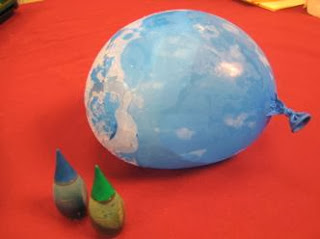 |
| ice..ice..baby duh duh dunt dunt duh source: NOAA |
 Why does ice float?
Why does ice float?
You've watched Titanic and seen those beautiful pictures of majestic icebergs weighing more than a building floating along in the ocean. How is that possible?Usually solids are the more dense than liquids. For a substance to float is has to be less dense (density=mass/volume) than the medium it is in...right but ice is made of water and it's in water so what gives?
Water is unique because it likes to stick together with other water molecules via hydrogen bonds. This is why it has high surface tension and is able to form droplets.
The molecules that make up water (aka H20) each have opposite charges and when water cools below 4ºC about 39ºF the hydrogen holds the negatively charged oxygen atoms apart from each other creating a crystal lattice formation or more commonly called ice.
Unlike most substances when water cools and freezes into ice it actually expands by 9% and becomes less dense allowing the solid ice chunks to float in water. This is why pipes can burst in the winter time and ice is excellent at weathering large rocks over time as it seeps in to tiny cracks.
Why don't fish freeze to death in the winter?
Ice always freezes from top down if it froze from bottom up fish would die first! You would see tons of dead fish every spring eeww. What happens is the colder water at the top freezes and floats while the heavier (slightly warmer) water sinks to the bottom. It sort of insulates the rest of the lake. If it ice sank it would cause the water from bottom to move up and then the lake would freeze solid..jpg) Fish are cold blooded so their metabolism depends on the temperature. The gradual change of temperature allows their body to adjust and survive through the cold temperatures. If the lake is large enough there will be a layer of liquid water at a constant temperature always at the bottom allowing the fish to survive. One other key things is that cold water holds more oxygen in it's solution so there is more oxygen available for the fish to use that are under a layer of ice.
Fish are cold blooded so their metabolism depends on the temperature. The gradual change of temperature allows their body to adjust and survive through the cold temperatures. If the lake is large enough there will be a layer of liquid water at a constant temperature always at the bottom allowing the fish to survive. One other key things is that cold water holds more oxygen in it's solution so there is more oxygen available for the fish to use that are under a layer of ice. There are many more things colder than ice if you want to study them look into the field of: Cryogenics: The branches of physics and engineering that involve the study of very low temperatures, how to produce them, and how materials behave at those temperatures.
My favorite cryogenic activity is to make liquid nitrogen ice cream... but that is a don't try it home experiment. Instead with careful adult supervision you can make dry ice ice-cream. I found this to be my favorite recipe. It's a very unusual texture and is almost fizzy! Be sure to mash your dry ice into a dust and use protective clothes as it is very cold and can burn skin easily if touched or swallowed in large chunks.
Want to explore more about ice and cold? Try out this cool experiment (not just for kids). It was one of the first ones I ever taught and study teaching but love to use it over and over. Lots of fun and easy to do! Great for all sorts of investigation and questioning experiments extensions. Plus it just looks really cool.
ICE BALLS
materials: water balloon, freezer (or very cold weather) water, food color, flashlight, pie pan, salt
Freeze water balloons a few days ahead of time. You want to fill them up to be big enough to cup in both hands or smaller. Unwrap balloon and discard, place in pan to catch drips and begin to observe in a dark room with a flash light
 |
| Each balloon is unique! |

Pour salt over ice and watch it melt you can experiment with other things like sugar and flour with out telling kids what the substances are. Add food coloring to follow the trails of melt.




No comments:
Post a Comment